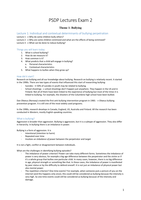PSDP Lectures Exam 2
Theme 1: Bullying
Lecture 1: Individual and contextual determinants of bullying perpetration
Lecture 1 Why do some children bully others?
Lecture 2 Why are some children victimized and what are the effects of being victimized?
Lecture 3 What can be done to reduce bullying?
Things you will learn today:
1. What is school bullying?
2. How do we measure it?
3. How common is it?
4. What predicts that a child will engage in bullying?
a. Personal characteristics
b. Contextual characteristics
5. What happens to bullies when they grow up?
How did it start?
Research on bullying and all our knowledge about bullying. Research on bullying is relatively recent. It started
in the 1990s. There are two types of events that influenced this start of researching bullying:
- Suicides 50% of suicides in youth may be related to bullying.
- School shootings school shootings don’t happen just anywhere. They happen in the US and in
Finland. Not all of them have been linked to the experience of bullying but most of the times it is
linked to bullying. For example, the shooters of the Columbine high school have been bullied.
Dan Olweus (Norway) created the first anti-bullying intervention program in 1983. Olweus bullying
prevention program. It is still one of the most widely used programs.
In the 1990s, research develops in Canada, England, US, Australia and Finland. All the research has been
conducted in Western, mostly English-speaking countries.
What is bullying?
Aggression is broader than aggression. Bullying is aggression, but it is a subtype of aggression. They also differ
in hierarchy. In bullying there is an imbalance in power.
Bullying is a form of aggression. It is
- Intentional (intention to harm)
- Repeated over time
- Involves an imbalance of power between the perpetrator and target
It is not a fight, conflict or disagreement between individuals.
What are the challenges in identifying bullying episodes?
- The imbalance of power criterion? Power can take many different forms. Sometimes the imbalance of
power is very obvious, for example a big age difference between the perpetrator and the victim or if
it’s a whole group that bullies one particular child. In many cases, however, there is no big difference
in age, physical strength or something like that. In these cases, the imbalance of power is manifested
by peer status or by the difficulty to defend oneself. It is not just an imbalance of physical power but
also mental power.
- The repetition criterion? One-time events? For example, when someone puts a picture of you on the
internet (and this happens only once), this could still be considered as bullying because the intensity is
very high. So one-time events could still be considered as bullying because of the intensity and
damage.
1
Theme 1: Bullying
Lecture 1: Individual and contextual determinants of bullying perpetration
Lecture 1 Why do some children bully others?
Lecture 2 Why are some children victimized and what are the effects of being victimized?
Lecture 3 What can be done to reduce bullying?
Things you will learn today:
1. What is school bullying?
2. How do we measure it?
3. How common is it?
4. What predicts that a child will engage in bullying?
a. Personal characteristics
b. Contextual characteristics
5. What happens to bullies when they grow up?
How did it start?
Research on bullying and all our knowledge about bullying. Research on bullying is relatively recent. It started
in the 1990s. There are two types of events that influenced this start of researching bullying:
- Suicides 50% of suicides in youth may be related to bullying.
- School shootings school shootings don’t happen just anywhere. They happen in the US and in
Finland. Not all of them have been linked to the experience of bullying but most of the times it is
linked to bullying. For example, the shooters of the Columbine high school have been bullied.
Dan Olweus (Norway) created the first anti-bullying intervention program in 1983. Olweus bullying
prevention program. It is still one of the most widely used programs.
In the 1990s, research develops in Canada, England, US, Australia and Finland. All the research has been
conducted in Western, mostly English-speaking countries.
What is bullying?
Aggression is broader than aggression. Bullying is aggression, but it is a subtype of aggression. They also differ
in hierarchy. In bullying there is an imbalance in power.
Bullying is a form of aggression. It is
- Intentional (intention to harm)
- Repeated over time
- Involves an imbalance of power between the perpetrator and target
It is not a fight, conflict or disagreement between individuals.
What are the challenges in identifying bullying episodes?
- The imbalance of power criterion? Power can take many different forms. Sometimes the imbalance of
power is very obvious, for example a big age difference between the perpetrator and the victim or if
it’s a whole group that bullies one particular child. In many cases, however, there is no big difference
in age, physical strength or something like that. In these cases, the imbalance of power is manifested
by peer status or by the difficulty to defend oneself. It is not just an imbalance of physical power but
also mental power.
- The repetition criterion? One-time events? For example, when someone puts a picture of you on the
internet (and this happens only once), this could still be considered as bullying because the intensity is
very high. So one-time events could still be considered as bullying because of the intensity and
damage.
1


